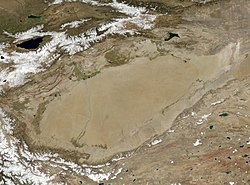
Back Tarimrivier Afrikaans نهر تاريم Arabic نهر تاريم ARZ Тарым Byelorussian Тарим Bulgarian তারিম নদী Bengali/Bangla Tarim (stêr) Breton Riu Tarim Catalan Tarim He CEB Tarim Czech
| Tarim | |
|---|---|
 | |
 Map showing the rivers of the Tarim Basin | |
| Location | |
| Country | China |
| Location | Xinjiang |
| Physical characteristics | |
| Source | confluence of Yarkand and Aksu |
| Mouth | Taitema Lake |
• coordinates | 39°28′N 88°19′E / 39.467°N 88.317°E |
| Length | 1,321 km (821 mi)[1] |
| Basin size | 1,020,000 km2 (390,000 sq mi)[1] |

The Tarim River (Chinese: 塔里木河; pinyin: Tǎlǐmù Hé; Uyghur: تارىم دەرياسى, romanized: Tarim deryasi), known in Sanskrit as the Śītā,[2] is an endorheic river in Xinjiang, China. It is the principal river of the Tarim Basin, a desert region of Central Asia between the Tian Shan and Kunlun Mountains. The river historically terminated at Lop Nur, but today reaches no further than Taitema Lake before drying out.
It is the longest inland river in China.[1] The Tarim River originates from the Karakoram Mountains and flows into Lop Nur along the northern edge of the Taklimakan Desert. It has a total length of 2,327 kilometers and a drainage area of 1.02 million square kilometers. Its main tributaries include the Hotan River, the Aksu River, and the Kashgar River. The course of the Tarim River swings from north to south in history, and its migration is uncertain. The last major river change occurred in 1921, when the main stream was diverted to the east and flowed into Lop Nur through the Kongque River. In 1952, a dam was built near Yuli County, separated from the Kongque River, and the river water returned to Taitma Lake and Lop Nur through the old road of Tieganlik.[3]
© MMXXIII Rich X Search. We shall prevail. All rights reserved. Rich X Search